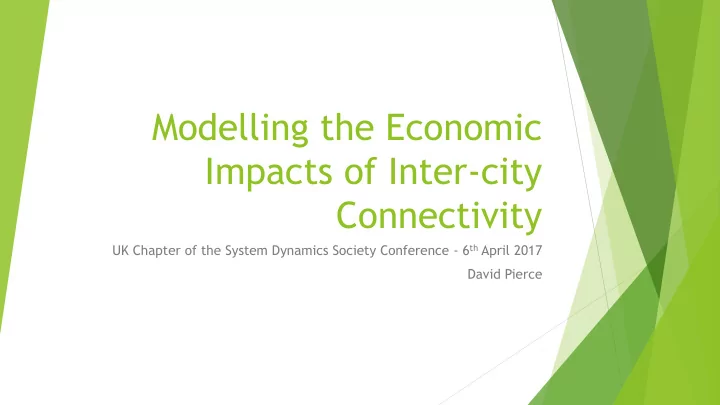

Modelling the Economic Impacts of Inter-city Connectivity UK Chapter of the System Dynamics Society Conference - 6 th April 2017 David Pierce
Structure of Presentation Research Background Research Objectives Ricardo’s Theory of Comparative Advantage New Economic Geography Long-run economic growth models System Dynamics Modelling Research Work Programme Used under license from Shutterstock.com
Research Background Current inter-city connectivity investment schemes: Northern Transport Strategy, HS2, TEN-T , etc. Rationale is improved economic performance Appraisal methods focus on direct cost savings and urbanisation effects not trade and specialisation There is no complete method currently available for assessing inter-city connectivity benefits which Goods, Services, potentially may be significant Labour, Investment, Ideas, etc.
Research Objectives 1. To develop an economic framework in which the economic impacts of improved inter-city connectivity can be seen through 2. To understand the dynamic processes of how inter- city connectivity impacts on economic activity 3. To understand the length of transition to a new steady state which inter-city connectivity may induce 4. To identify the level of additionality to transport user benefits in a cost benefit analysis that increased productivity through specialisation will have 5. To apply the model and new techniques to relevant case studies Used under license from Shutterstock.com
Ricardo’s Theory of Comparative Advantage Images used under license from Shutterstock.com
New Economic Geography Used under license from Shutterstock.com Centripetal Forces Centrifugal Forces - Market size effects - Immobile factors - Thick labour markets - Land rents - Pure External Economies - Pure External Diseconomies Source: Krugman (1998)
Long-run Economic Growth Models The Solow-Swan Model of economic growth was developed in the 1950s Production function in Cobb-Douglas form: 𝑍 = 𝐵𝐿 𝛽 𝑀 1−𝛽 Fundamental differential equation of model: ሶ 𝑙 = 𝑡𝑔 𝑙 − (𝜀 + 𝑜)𝐿 Source: Abreu (2014)
System Dynamics Modelling System Dynamics representation of Solow-Swan model based on Kunte and Damani (2016), “Exploring Harrod-Domar and Solow Models of Economic Growth” Firm capital ( K ), Population ( N ) and household capital ( HC ) are represented as stocks in the system dynamics model as they can accumulate over time subject to inflows and outflows The net flow of each of these variables are expressed using the following formulas: 𝑢 𝐿(𝑢) = න 𝑡𝑍 𝑡 − 𝜀𝐿(𝑡) 𝑒𝑡 + 𝐿(𝑢 0 ) (1) 𝑢 0 𝑢 𝐼𝐷(𝑢) = න 𝑍 𝑡 − 𝑑 + 𝑡 𝑍(𝑡) 𝑒𝑡 + 𝐼𝐷(𝑢 0 ) (2) 𝑢 0 𝑢 𝑂(𝑢) = න 𝑜𝑂 𝑡 𝑒𝑡 + 𝑂(𝑢 0 ) (3) 𝑢 0
System Dynamics Modelling Non-spatial Solow-Swan Economic Growth Model Based on Kunte and Damani (2016)
System Dynamics Modelling Results Non-spatial Solow-Swan Economic Growth Model
Research Work Programme
Thanks for Listening Any Questions?
References Abreu, M. (2014), Neoclassical Regional Growth Models, in (eds.), Fischer, M. M. and P . Nijkamp, Handbook of Regional Science, Berlin: Springer. Krugman, P . (1998), What’s New About The New Economic Geography?, Oxford Review of Economic Policy, Vol. 14, No. 2, pp7-17. Kunte, S. and O. Damani (2016), Exploring Harrod-Domar and Solow Models of Economic Growth, in proceedings of The 34th International System Dynamics Conference, System Dynamics Society, Delft, The Netherlands, pp1-23. Ricardo, D. (1817), On the Principles of Political Economy and Taxation, London: John Murray. Romer, P .M. (1986), Increasing Returns and Long-Run Growth, Journal of Political Economy, Vol. 94, pp1002-37. Solow, R.M. (1956), A Contribution to the Theory of Economic Growth, Quarterly Journal of Economics, Vol. 70, No. 1, pp65-94. Swan, T .W. (1956), Economic Growth and Capital Accumulation, Economic Record, Vol. 32, Issue 2, pp334-361.
Recommend
More recommend